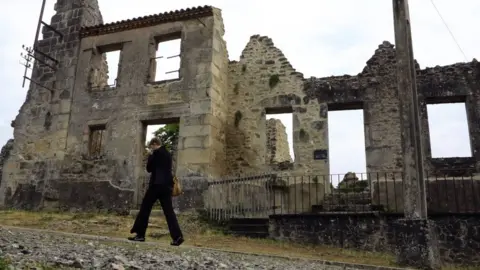Oradour-sur-Glane: Uproar after France Nazi massacre site vandalised
 Reuters
ReutersFrench President Emmanuel Macron has condemned as "unspeakable" the defacing of a memorial at the site of one of the worst atrocities carried out by the Nazis in France during World War Two.
Images of an inscription at the site in the village of Oradour-sur-Glane show the word "martyr" in the text "martyr village" replaced with "liar".
The village was destroyed by SS troops in 1944, with 642 inhabitants killed.
The old village's ruins are preserved just as they were after the massacre.
After the war, a new village was built nearby.
Philippe Lacroix, the mayor of Oradour-sur-Glane, said he was shocked, adding: "We know what happened here but obviously there are always people who try to tell lies."
Mr Macron said that everything would be done to track down and punish those responsible for the vandalism.
The act has been widely condemned by French officials.
Prime Minister Jean Castex said he felt "anger" when he heard of the incident. "To soil this place... is also to soil the memory of our martyrs," he said.
"Shame on those who did this," Justice Minister Eric Dupond-Moretti tweeted.
French Interior Minister Gérald Darmanin described the vandalism as "spitting on the memory of our martyrs".
What happened to the village?
On 10 June 1944, a detachment of SS troops surrounded the tiny hamlet of Oradour-sur-Glane in the Limousin region of south-central France.
It is believed by some that the troops were seeking retribution for the kidnap of a German soldier but some say that resistance members were based in a different, nearby village.
Most of the victims were women and children. Many of them were herded into a local church into which hand grenades were thrown before it was set on fire.
The men were locked in a barn. Machine-gunners shot at their legs, then doused them in petrol and set them alight.
An investigation years later saw some 60 soldiers brought to trial in the 1950s. Twenty of them were convicted but all were later released.
